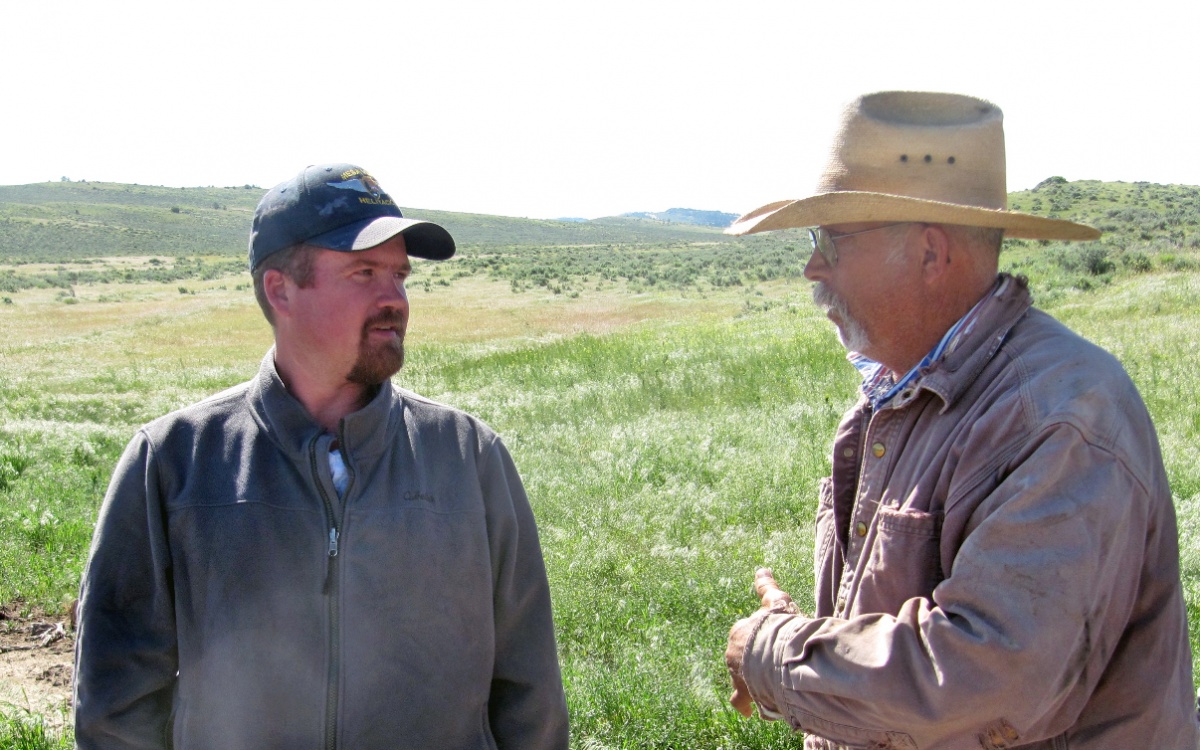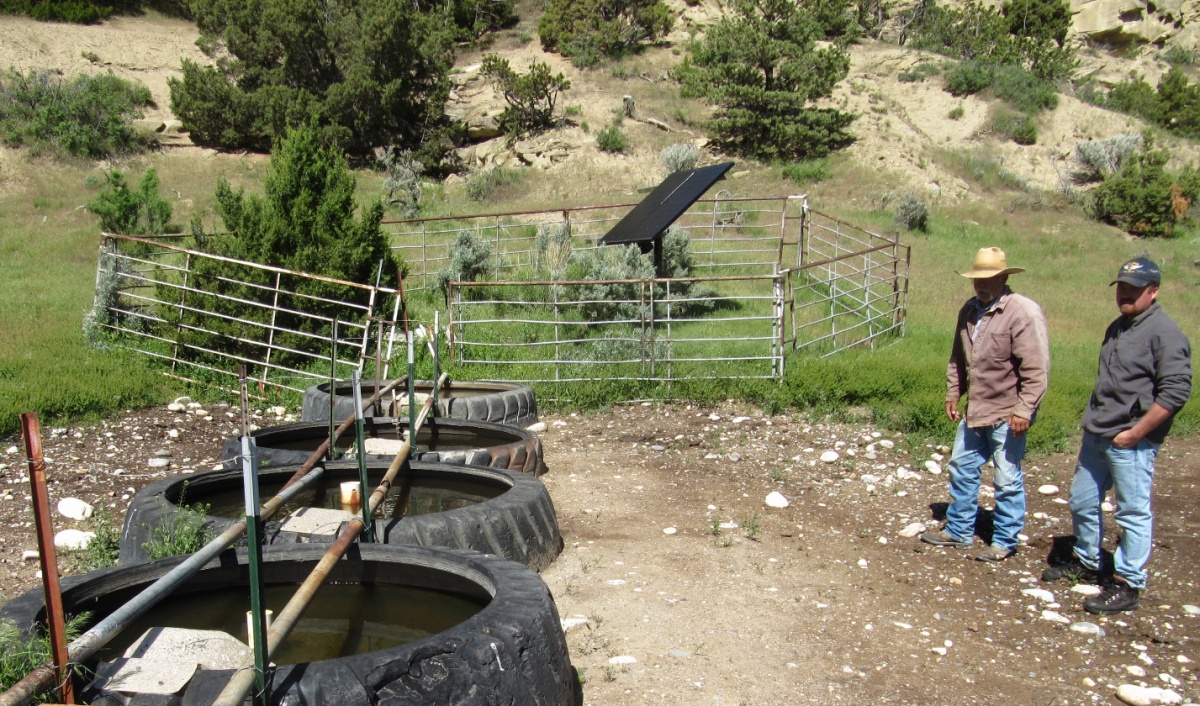You are viewing ARCHIVED content published online before January 20, 2025. Please note that this content is NOT UPDATED, and links may not work. Additionally, any previously issued diversity, equity, inclusion or gender-related guidance on this webpage should be considered rescinded. For current information, visit https://www.blm.gov/blog.
Meet the Stovall's--Typical BLM Permittees
Story and photos by Floyd Thompson, Rangeland Management Specialist, Montana/Dakotas State Office

Management Specialist, and Bill Stovall, Cottonwood
Allotment Permittee, discuss range conditions and plans.
Bill Stovall is a third generation Montanan ranching in the south central part of the state. Bill’s family has ranched in Montana since the late 1800s when his grandfather moved to the state. Bill’s parents owned and operated a number of ranches near Luther, Boyd and Hardin. This upbringing instilled a lifelong passion for ranching that he has pursued his whole life.
Bill, along with his wife Shannon and daughter Seara, are now based near Bridger where they run their 350-head cow-calf operation on a number of leased properties in Carbon and Stillwater counties. Bill states that due to the high land prices in the area, many ranching operations in this region operate on a leased property basis. Bill estimates that nearly 80 percent of cattle operations in south-central Montana lease all or part of the pasture they require for their cattle herds.
Eight years ago, Bill and Shannon started leasing the base property for the Cottonwood Allotment permit administered by the Billings Field Office. The Cottonwood Allotment encompasses roughly 11,500 acres, of which a little more than half is public land. The other part of the allotment is mostly private along with two hundred acres of Montana school trust lands. The Cottonwood Allotment provides forage for one of the Stovalls’ herds from spring to fall.
The intermingled nature of public and private lands in the allotment poses unique challenges and opportunities for permittees. Bill says the previous permittee thought the forage conditions and limited water in the allotment were not worth renewing the base property lease. Bill and Shannon, on the other hand, saw potential in the allotment and seized the opportunity.
When they started their tenure on the allotment, the allotment was divided into two pastures and the water sources were limited or dysfunctional. Bill immediately started working on the water situation with the base property owner—Don Beck—and former BLM Billings Field Office Rangeland Management Specialist Dusty Crowe. Bill outfitted the existing wells with solar panels for more reliable pumping capacity. Dusty worked through the BLM range improvement program to drill another well. Additionally, Bill and Dusty strategically altered the fencing or placed the wells so multiple pastures can be watered by the same well.
Bill and Dusty also worked on a plan to divide the two pastures into five. Although it took four or five years from a notion to posts in the ground, the fencing was completed last year. Approximately 7.5 miles of fence on public and private was constructed to create the pastures. Bill is excited to start rotating his herd through the new pasture configuration to continue improving the range conditions.
Bill, Shannon, and Seara regularly ride throughout the allotment to check on cattle, gates, and range conditions. Additionally, their horse riding friends help keep an eye on the herd when they visit. The Stovalls developed a relationship with an endurance race horse rider who also keeps an eye on things while training her Arabians.

Bill says habitat is improving for a number of wildlife species as well. Bill is seeing more mule deer and antelope in the area than he did eight years ago. Bill states he commonly flushes gamebirds such as pheasants, sharptail grouse and Hungarian partridges as well.
Not one to rest upon past accomplishments, Bill continues to think of ways to improve the conditions on the allotment. Bill is working with current Billings Field Office Rangeland Management Specialist Shane Trautner on re-constructing a spring development, removing an unneeded fence, and locating a couple of pit reservoirs.
The Cottonwood Allotment is located in an area frequently visited by a multitude of public land users. Folks visit the area to ride mountain bicycles, drive OHVs, ride motorcycles, hike, hunt, shoot, sightsee, view petroglyphs, study paleontological resources, and ride horses for pleasure.
According to Bill, while most users respect his operation, a few people have vandalized a well on private land and stolen items from another on public land. Bill worked with the Carbon County Sheriff and BLM Law Enforcement on the incidents; unfortunately no leads were discovered to identify the culprits. Shannon is a stickler about trash; she regularly cleans up messes such as beer cans, alcohol bottles and shotgun shell casings left by miscreants. Despite the expenses, disruptions, and aggravations caused by the vandals, Bill maintains that his tenure on the allotment has been a good experience. Bill and Shannon are proud of what they have accomplished so far. Bill is pleased with the open dialogue and good relationship he has with the Billings Field Office staff and Shane Trautner. As Bill states, “I don’t think we could have a better working relationship.”
Thank you to Bill and Shannon—outstanding examples of Montana/Dakotas’ “typical” permittees.
Related Stories
- Monument map earns ‘finalist’ honors in global GIS awards
- BLM Fire and National Conservation Lands managers collaborate to meet shared goals
- Recreation for all: Accessibility on Montana-Dakotas public lands
- North Central Montana District employees celebrate new adoption
- BLM Billings Field Office works with state agencies in Montana to conduct bat surveys
